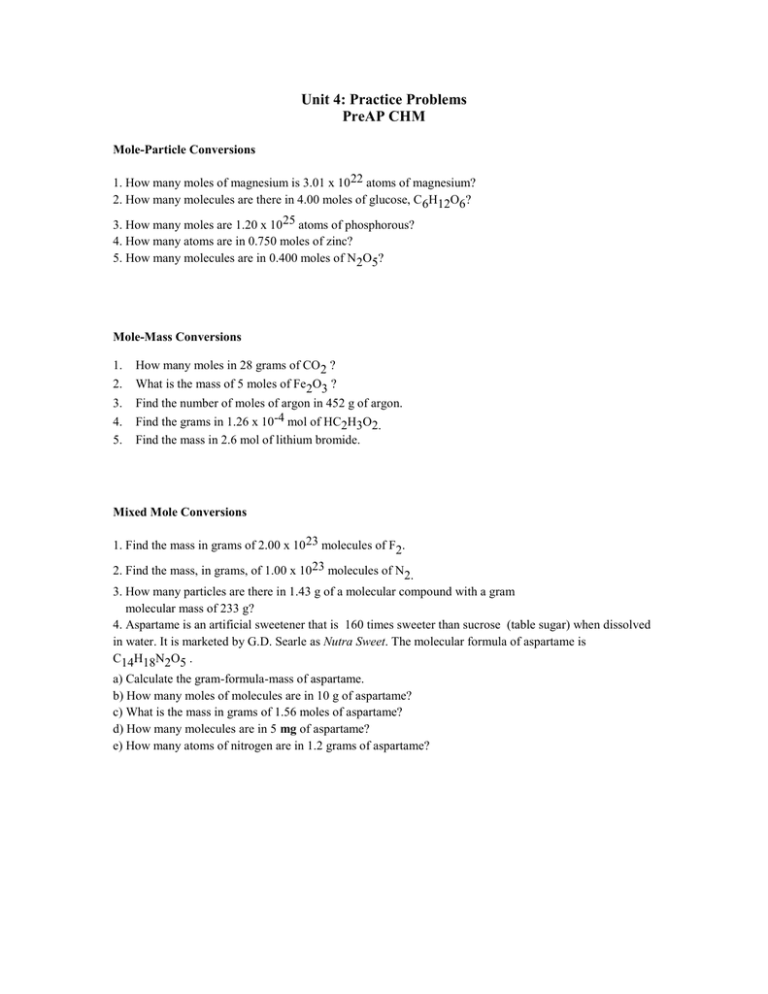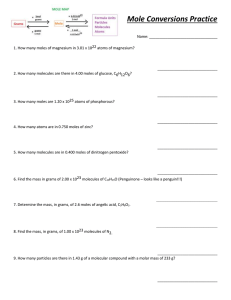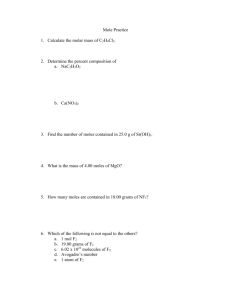Unit 4 Mixed Practice Problems
advertisement

Unit 4: Practice Problems PreAP CHM Mole-Particle Conversions 1. How many moles of magnesium is 3.01 x 10 22 atoms of magnesium? 2. How many molecules are there in 4.00 moles of glucose, C6H12O6? 3. How many moles are 1.20 x 1025 atoms of phosphorous? 4. How many atoms are in 0.750 moles of zinc? 5. How many molecules are in 0.400 moles of N2O5? Mole-Mass Conversions 1. How many moles in 28 grams of CO2 ? 2. What is the mass of 5 moles of Fe2O3 ? 3. Find the number of moles of argon in 452 g of argon. Find the grams in 1.26 x 10-4 mol of HC2H3O2. Find the mass in 2.6 mol of lithium bromide. 4. 5. Mixed Mole Conversions 1. Find the mass in grams of 2.00 x 10 23 molecules of F2. 2. Find the mass, in grams, of 1.00 x 1023 molecules of N2. 3. How many particles are there in 1.43 g of a molecular compound with a gram molecular mass of 233 g? 4. Aspartame is an artificial sweetener that is 160 times sweeter than sucrose (table sugar) when dissolved in water. It is marketed by G.D. Searle as Nutra Sweet. The molecular formula of aspartame is C14H18N2O5 . a) Calculate the gram-formula-mass of aspartame. b) How many moles of molecules are in 10 g of aspartame? c) What is the mass in grams of 1.56 moles of aspartame? d) How many molecules are in 5 mg of aspartame? e) How many atoms of nitrogen are in 1.2 grams of aspartame? Unit 4 Mixed Practice Problems 1. Determine the empirical and molecular formulas of each of the following substances: (a) caffeine, a stimulant found in coffee that contains 49.5% C, 5.15% H, 28.9% N, and 16.5 % O by mass; molar mass approximately 195 g/mol. (b) monosodium glutamate (MSG), a flavor enhancer in certain foods that contains 35.53% C, 4.77% H, 37.85% O, 8.29 % N, and 13.60% Na; molar mass of 169 g/mol. 2. What is the molecular formula of each of the following compounds? (a) empirical formula is NO2, molecular mass is 138 g/mol (b) empirical formula is CH2, molecular mass is 98 g/mol 3. Name (state the nomenclature or formula) and calculate the percentage composition of following compounds: (a) Mg(NO3)2 (b) (NH4)3PO4 (c) iron (III) oxide (d) phosphoric acid 4. Calculate the following quantities (with special attention to significant figures): (a) mass of carbon, in grams, of 2.52 g of barium acetate (b) moles of nitrogen in 3.12 g magnesium nitrite (c) number of molecules of oxygen in 0.2405 g triphosphorus trioxide 5. Determine the empirical formulas of the compounds with the following compositions by mass: (a) 40% C, 6.7% H, and 53.5% O (b) 21.7% C, 9.6% O, and 68.7% F (c) 22.1 % Al, 25.4% P, and 52.5% O 6. Write the formulas for the following compounds AND determine their percent composition: (a) iron (II) phosphite (b) ammonium phosphate (c) potassium permanganate (d) iodic acid 7. Write the nomenclature for the following compounds AND determine the amounts asked for: (a) How many molecules of oxygen are there in 6.78 g of N2O4? (b) How many grams of H are there in 7.23 x 10 24 atoms of Zn3(PO4)2 · 4H2O (c) How many moles of nitrogen are there if you have 0.323 kg of Ca(NO3)2? 8. A sample of aluminum hydroxide, contains 5.77 x 10 20 molecules of oxygen. (a) How many grams of aluminum does it contain? (b) How many grams of aluminum hydroxide are there? 9. Describe the differences in the naming of ionic compounds, molecular compounds, and acids. 10. In the lab, you find the density of a substance to be 2.39 g/mL, but after researching the substance on the internet, you find the true density (you could say the theoretical density) to be 2.57 g/mL, what would your % error be? 11. Research and find out why diatomic molecules exist. State how we remember them in class.

